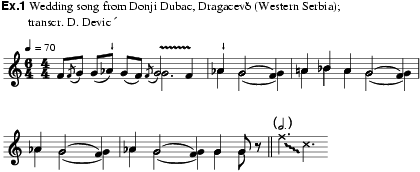
(Serb. Savezna Republika Jugoslavija).
Country in eastern Europe. Yugoslavia consists of the republics of Serbia and Montenegro and the autonomous provinces within Serbia of Kosovo, Metohija and Vojvodina. It has a population of about 10·5 million people (2000 estimate) and was formed in April 1992 following the break up of the socialist republic, which had also included Bosnia-Hercegovina, Croatia, Macedonia and Slovenia. The official language is Serbian, written in Cyrillic. The majority of the population is Orthodox Christian, but there are large Muslim minorities, especially in Kosovo and Metohija. Ethnically Kosovo and Metohija are 80% Albanian, and there is a large Hungarian minority in Vojvodina. Gypsies are present in almost every region of Yugoslavia.
DRAGOSLAV DEVIĆ (I; III, 1–2), ROKSANDA PEJOVIĆ (II), JANE SUGARMAN (III, 3)
In the 5th–7th centuries ce parts of south-eastern Europe were settled by Slavonic tribes arriving from the north. Orthodox Christianity was adopted by the south Slavs in the 9th century, and the medieval Serbian state established close relations with Byzantium and its culture (manifest in liturgical music). The medieval state was destroyed by the Turks at the battle of Kosovo in 1389; there then followed five centuries of Ottoman rule. This period of Turkish domination particularly influenced urban musics, in instrumentation and melodics, and also the rural musics of Muslim populations. Following Venetian conquests in the Mediterranean, western European musical influences, especially from Italy, increased along the Montenegrin coast and in the Bay of Kotor.
At the end of the 17th century, contact was re-established with central European culture. Gradually, during the 18th century, cultural influence from the Austro-Hungarian monarchy spread among the Serbian population of Vojvodina. This influence spread southwards into the central regions of Serbia and contributed to the uprisings against the Turks and the liberation of Serbia in 1867. From then onwards urban populations became increasingly open to influence from western Europe, unlike people in the mountainous regions of Serbia and Montenegro who continued to maintain their traditional instruments and music.
The history of art music in the region began after the arrival and Christianization of Serbs and other Slav tribes in the 9th century. Under Byzantine influence, they developed church music in their own language, and from the 12th century onwards they had an independent state, which under Emperor Stefan Dušan (1331–55) held territory from the Sava and the Danube down to the Gulf of Corinth.
Serbian chant followed the Byzantine system of eight modes and included both syllabic and melismatic settings of hirmos, troparions, kontakions and other hymns. Some were composed as text and music together (idiomela); some melodies were taken as models (automela) for settings of other texts (prosomoia). After the defeat of the Serbs by the Turks at the Battle of Kosovo in 1389, manuscripts were made to preserve Serbian chant — including compositions by Stephen the Serb, Nicholas the Serb and Isaiah the Serb — in middle Byzantine neumatic notation.
During the Turkish occupation, which lasted until the 19th century, Serbian church music had to continue largely in secret. Many manuscripts were kept at the monastery of Chilandar on Mount Athos, which had been established by Emperor Stefan Nemanjić (1166–1196), founder of the ruling dynasty. These manuscripts have late Byzantine neumes and texts in Greek, Greek Slavonic, Russian and Church Slavonic, including texts from the liturgies of Serbian saints (St Simeon, St Sava etc.). The manuscripts are from the 18th century (sticherons from the oktōēchos) and are akin to Greek, Bulgarian and Russian sources of the period.
Secular music was cultivated at the courts of the emperors and noblemen. Stefan Prvovenčani, the son of Nemanjić, had musicians playing the gusle and kettledrum in his service and Stefan Dušan's musicians were the trumpeter Dragan of Prizren, Preda and the blind Hrusa. Musicians from the courts of Serbia, Bosnia (where King Tvrtko II, d 1443, had a band of dancers, instrumentalists and actors), Hercegovina and Montenegro all played in Dubrovnik. Some indication of their activities may perhaps be gleaned from frescoes in Serbian churches and monasteries (Bogorodica Ljeviška, Nagoričane, Dečani), miniatures, icons in Byzantine style and reliefs (at Dečani and Kalenić).
The Great Migration of Serbs under Patriarch Arsenije III Čarnojević in 1690, and later migrations into southern Hungary, led to changes in church music. Greek and Russian chant schools were founded — Greek from 1721 in Belgrade and other towns, Russian from 1726 in Sremski Karlovci and elsewhere — and the Serbs accepted Church Slavonic in their liturgy. Also, Ukrainian teachers introduced the Baroque style of western Europe in songs and incidental music. Four songs in Russian square notation were copied into a luxury manuscript, Pozdrav Mojseju Putniku (‘Respect to Mojsej the traveller’), whose author, the engraver Zaharije Orfelin (1726–85), may well have been their composer. During the same period, Serbian dramas and oratorio-like works were performed with music in Boka Kotorska.
The Classical and Romantic styles had their Serbian representatives. Kornelije Stanković (1831–65) was the first to use traditional music and the first to transcribe Serbian chant into staff notation in his Pravoslavno crkveno pojanje u srpskoga naroda (‘The Orthodox Church chant of the Serbian people’, 1862–4).
From the 1880s onwards, Serbian composers, especially those living on the borders of Austria-Hungary, wrote music for Serbian plays and choral societies, employing traditional music and expressing a nationalist ideology. The most original of them was Stevan Mokranjac (1856–1914), who studied in Munich, Rome and Leipzig. His works include choral pieces (Rukoveti, ‘Handfuls’, 1883–1909), church music and editions of traditional music and chant. With the Beogradsko Pevačko Društvo (Belgrade Choral Society) he gave concerts all over Europe between 1894 and 1899. His contemporary Josif Marinković (1851–1931) studied at the Prague Conservatory, conducted the Obilić choir, and wrote songs, choral pieces and church music. Among many Czech musicians who espoused the Serbian cause, Robert Tolinger (1859–1911) was editor-in-chief of the first Serbian musical magazine, Gudalo (‘The bow’, 1886–7). The Slovenian Davorin Jenko (1835–1914) also contributed to the development of Serbian music with his choruses and incidental music.
The leaders of the next generation were Stanislav Binički (1872–1942) and Isidor Bajić (1878–1915). Binički conducted the first Belgrade performances of major choral works (Haydn’s Creation in 1908, Beethoven's Ninth in 1910) and directed the choir of the Muzičko Društvo Stanković (Stanković Music Society) and the Muzika Kraljeve Garde (Music of the Royal Guard). His opera Na uranku (‘At Dawn’) shows the influence of verismo, Serbian and Asian traditional song; he also wrote songs and choral pieces. Bajić was editor of the Srpski muzički list (‘Serbian music magazine’, founded 1903), published the music of Serbian composers in his Srpska Muzička Biblioteka (Serbian Music Library, 1903–4) and founded a music school in Novi Sad in 1909. His works, showing similar influences to Binički's, include the opera Knez Ivo od Semberije (‘Prince Ivo of Semberia’, 1910), songs and piano miniatures.
Between the two world wars Belgrade's musical culture, as represented by its opera house, concert season and music magazine (Zvuk), was thriving and there were composers to match. Those continuing a late Romantic style included Petar Stojanović (1877–1957) and Milenko Paunović (1889–1924); among those who used traditional elements within the same tradition were Petar Kristić (1877–1957) and Kosta Manojlović (1890–1949).
Other composers of this period developed the national style in more modern directions. Petar Konjović (1883–1970) studied in Prague, and followed Janáček in the brilliant orchestration and speech-like melody of his operas. Miloje Milojević (1884–1946) studied in Munich and France as well as Prague, so that Impressionist and Expressionist tendencies emerged in his music, the former in his much loved song collection Pred veličanstvom prirode (‘Before the Magnificence of Nature’, 1982), piano and orchestral pieces. Stevan Hristić (1885–1958) was also a Romantic Impressionist in his opera Suton (‘The Dawn’, 1925) and his ballet Ohridska legenda (‘The Legend of Ohrid’, 1947) is a classic of the national school. Josip Slavenski (1896–1955), a Croat who lived in Belgrade from 1924 onwards, used Balkan (Balkanofonija, ‘Balkanophy’ 1927) and Asian traditional music in his best works. Younger composers who remained within the national tradition included Marko Tajčević (1900–84), Mihailo Vukdragović (1900–86), Milenko Živković (1901–64), Predrag Milošević (1904–88) and Vojislav Vučković (1910–42).
Musical life took another step forward after World War II. Certain singers, instrumentalists, ensembles and choirs began to gain a reputation outside Yugoslavia, and a new creative spirit emerged in the works of Stanojlo Rajičić (b 1910), Milan Ristić (1908–82), Dragutin Čolić (1907–87), Ljubica Marić (b 1909) and Nikola Hercigonja (b 1911). Ristić's much awaited nine symphonies (1941–76) broke with the national style and took on neo-classicism; Čolić more radical than his colleagues, composed quarter-tone music and used 12-note methods in combination with tonality; Marić found inspiration for her primeval expressions in the Serbian past (cantata Pesme prostora, ‘Songs of Space’; the cycle for various settings Muzika oktoiha, ‘The Music of Octoëhos). But national Romanticism continued to thrive, alongside more contemporary styles (neo-classicism, serialism and later the colour-field music of the Polish school). Composers of a more conservative persuasion included Vojislav Ilić (b 1912–99), Dragutin Gostuški (b 1923–98), Kosta Babić (b 1927), Dušan Kostić (b 1925), Vasilije Mokranjac (1923–84) and Vlastimir Peričić (b 1927). Enriko Josif (b 1924), Dušan Radić (b 1929) and Dejan Despić (b 1930) embraced neo-classicism in various ways, while Vitomir Trifunović (b 1916) and Aleksandar Obradović (b 1927) moved from national Romanticism to 12-note and electronic music.
Younger composers who have similarly interested themselves in new techniques include Petar Ozgijan (1932–79), Slobodan Atanacković (b 1937), Zoran Hristić (b 1938) and Vuk Kulenović (b 1946). Rajko Maksimović (b 1935) evokes ancient Serbia by means of archaic modality; Milan Mihajlović (b 1945) works with Skryabinesque and other modes; and Vlastimir Trajković (b 1947) has used modes from other traditions and from Messiaen. Vladan Raovanović (b 1932), Srđan Hofman (b 1947) and Zoran Erić (b 1950) made electronic music.
MGG2(Z. Blažeković)
P. Konjović: Ličnosti [Personalities] (Zagreb, 1920)
M. Milojević: Muzičke studije i članci [Musical studies and articles] (Belgrade, 1926–53)
P. Konjović: Knjiga o muzici srpskoj i slovenskoj [A book of Serbian and Slavonic music] (Novi Sad, 1947)
P. Konjović: Ogledi o muzici [Essays on music] (Belgrade, 1965)
D. Stefanović: ‘The Serbian Chant from the 15th to 18th Centuries’, Musica antiqua Europae orientalis: Bydgoszcz and Toruń 1966, 140–63
V. Peričić,D. Kostić and D. Skovran: Muzički stvaraoci u Srbiji [Musical creators in Serbia] (Belgrade, 1969) [with Eng. summary]
S. Đurić-Klajn: A Survey of Serbian Music through the Ages (Belgrade, 1972)
D. Stefanović: Stara srpska muzika: primeri crkvenih pesama iz XV veka [Old Serbian music: examples of church songs from the 15th century] (Belgrade, 1974–5) [in Eng., Serbo-Croat]
Z. Kučukalić: Romantična solo-pjesma u Srbiji [Romantic song in Serbia] (Sarajevo, 1975) [with Eng. summary]
D. Stefanović: ‘Serbian Church Music through the Centuries’, Beiträge zur Musikkultur des Balkans, ed. R. Flotzinger (Graz, 1975), 128–38
M. Bergamo: Elementi ekspresionističke orijentacije u srpskoj muzici do 1945 [Elements of expressionistic orientation in Serbian music before 1945] (Belgrade, 1980) [with Ger. summary]
Kornelije Stanković i njegovo doba: Belgrade 1981 [summaries in Eng., Ger.]
D. Petrović: Osmoglasnik u muzičkoj tradiciji Južnih Slovena [Oktōēchos in the musical tradition of southern Slavs] (Belgrade, 1982) [with Eng. summary]
D. Petrović: ‘Crkveni elementi u srpskom narodnom obrednom pevanju’ [Church elements in Serbian ritual folksongs], Balcanica, xiii–xiv (1982–3), 463–78
R. Pejović: Predstave muzičkih instrumenata u srednjovekovnoj Srbiji [Musical instruments in medieval Serbia] (Belgrade, 1984) [with Eng. summary]
Folklor i njegova umetničke transpozicija [I]: Belgrade 1987 [summaries in Eng., Fr., Ger., Russ.]
Folklor i njegova umetnička transpozicija II: Belgrade 1989
Folklor i njegova umetnička transpozicija III: Belgrade 1991
Srpska muzička scena: Belgrade 1993 [summaries in Eng., Fr., Ger.]
M. Veselinović: Stvaralačka prisutnost evropske avangarde u nas [The European avant garde in our country] (Belgrade, 1993)
Folklor i njegova umetnička transpozicija IV: Belgrade 1997
R. Pejović and others: Srpska muzika od naseljavanja slovenskih plemana na Balkansko poluostrvo do kraja XVIII veka [Serbian Music from the settling of Slavonic tribes at the Balkan Peninsula to the end of the XVIII century] (Belgrade, 1998) [with Eng. summary]
3. Kosovo and related Albanian musical traditions.
Yugoslavia, §III: Traditional music
Yugoslavia, §III, 1: Traditional music: Serbia
Traditionally songs are sung by girls and women without instrumental accompaniment. The playing and making of musical instruments is largely the work of men. Songs are performed in two ways: monophonically and polyphonically, the latter mostly diaphonic. Songs may be divided into three categories: traditional (or rural), ‘new’ and urban. The most frequently performed songs today are love songs. Religious and traditional songs are gradually dying out because of rapidly changing social and economic conditions in rural areas.
Songs of a religious nature were usually sung to ensure the well-being of the community. They included Christmas carols (koledarske), songs sung on the eve of Lazar's Saturday (lazaričke), Pentecostal (kraljičke) and rain songs (dodolske), and they were sung to accompany simple, ritual dances. According to popular belief, these songs would ensure fertility and the renewal of the flora and fauna. They were sung in a specific order, during the first half of the year, from the winter to the summer solstice. Until recent times, these songs and dances continued to be performed in many villages, especially in the eastern and southern parts of Serbia.
During the winter, around Christmas, singers and masked dancers called koledari would for several days go from house to house in a village, singing Christmas (koledarske) songs to ensure the health and prosperity of the household. The masked dancers, with their characteristic dances and zoomorphic masks, symbolized the struggle between good and evil and the triumph of light over darkness that heralded the beginning of the new calendar year. Meanwhile groups of male singers, a shepherd and then a ploughman, would sing antiphonal lyrics. The dancers would usually perform in the house around the fireplace.
The week before Easter, on Lazar's Saturday (Willow Day), a group of village girls (singers and dancers) would visit each house, singing Easter songs (lazaričke) to invoke a bountiful harvest and good health for the head of the household and all its members. A similar custom of song and dance called kraljičke would be performed by girls of marriageable age. They would visit each village in their area during Pentecost and sing ritual songs.
If the summer has been very dry, girls gather together to summon up rain. They walk slowly through the village, stopping at each house to sing a set song. The smallest and youngest girl (called a dodola, ‘rainmaker’), adorned in greenery, constantly dances on the spot. The villagers will pour water over her in the belief that it will rain soon afterwards. In return for the ritual, the woman in charge of the household usually presents the participants with food and a variety of the fruits that are in need of rain.
The many other kinds of songs, which were not strictly associated with any particular time of the year, were performed mainly by girls. Of these, the most well known are wedding songs, followed by those that are sung during funerals. Wedding songs (svadbene pesme) were usually sung in the bridegroom's and bride's houses, for a few days before, during and after the wedding. The songs would vary according to their subjects and purpose and also according to the singers, who were called pevice, svadbarice or endje depending on whether they were related to the bridegroom or were friends of the bride. During the wedding ceremony, songs called svatovske were popular. They would be sung on the way to bride's house or as the bride was being taken back by the bridegroom's parents to their house. Similar wedding songs were intended primarily for the newlyweds, but also for other prominent people present at the wedding (the godfather, brother-in-law, wedding witness or the parents). The melodies were either monophonic or polyphonic and varied by region (ex.1, ex.2 and ex.3) .
When somebody dies, it is still traditional in many parts of Serbia to ‘wail’ (kukati), ‘cry’ (plakati), ‘lament’ (naricati) or sing laments (tužiti) for the deceased. The mourning of the deceased is the responsibility of the women members of the family or of the closest relatives. During the funeral songs, called tužbalice (‘laments’), a simple melody and suitable content are improvised according to an established model. In Serbia they are not called songs, they are known as ‘keening’ (kukanje) and ‘crying’ (plakanje) for the deceased.
The strižba, also known as šišano kumstvo, is a family celebration and ritual for a newborn child's first haircut. This is an ancient rite carried out by the child's godfather, the šišani kum. The striženje (‘shearing’) consists of the godfather smearing the child's locks with wax, cutting them off and presenting them to the parents for safekeeping. When he is finished, the godfather immediately places a new cap on the child's head. It is believed that in this way the child will be protected throughout its future life from evil spells and the Devil. Throughout the ritual, girls sing a shearing song (strižbarska pesma). Another common type of family song are lullabies (uspavanke), with simple melodies and improvised subject matter and form.
Girls would also sing while looking after the livestock, especially during the summer. In those parts where the population worked the soil, songs were sung during the harvest. The melody was usually sung with long drawn-out tones, and the song would unfold slowly with pauses. When two or three girls completed a verse with a cry, they would be echoed by the cries of the other girls. The songs were ballads that lasted a long time, during which the young men gathering the harvest would be allowed to rest (ex.4 and ex.5).
Song texts about many different subjects may be sung to a common melody or ‘voice’. ‘Voices’ are groups of notes that combine to form a melody in a particular verse form. Voices may be manipulated to derive related melodies from the original. Different texts, performed u glas or na glas (a loud, full-voiced melody sung in the open air), of the same genre and with the same metric structure may be fitted to these melodies. Wedding songs may also be sung like this (ex.1, ex.2 and ex.3). A voice can be identified by its geographical origins (zlatiborski, moravski, dragačevski), and its basic type can be determined according to whether it is ‘long’ (dugačak) or ‘short’ (kratak). When long tones predominate in the individual syllables of the text (usually in diaphonic singing), the song is performed na dugački glas (ex.1, ex.4 and ex.5), and when the syllables of the text are sung with short note-values, then the song is sung na kratak glas.
In order to start singing u glas, the singers assemble in pairs of the same gender and usually of the same age and height. In the western regions, two women or two men sing together, or in groups of three. In the eastern regions only two or three women ever sing together in order to achieve a uniform timbre of voice which is especially valued, known as ‘beautiful singing’ (lepo pevanje).
Songs sung alone are called samačke pesme (‘songs for a single person’). In Southern Pomoravlje, as well as in Kosovo and Metohija, all songs are sung monophonically, sometimes in a group (ex.2, ex.8 and ex.9). In western and eastern regions, where diaphonic singing is more widespread (ex.2, ex.4 and ex.5), the role of the singer is restricted and defined. The leading voice is defined by a special terminology. It can either ‘recite’ (izgovoriti), ‘pronounce’ (izreći), ‘cut in’ (usjeći) or ‘carry’ (zanositi). It is said that the accompaniment ‘chases’ (goni), ‘interrupts’ (presjeca) or ‘deepens’ (dube). These terms distinguish between the leading and accompanying parts in a polyphonic structure. In order to sing these songs polyphonically and in unison, the singers practise them from childhood. The posture of the singers differs with gender. For example, while singing, women join hands, held at chin height, and nod their heads towards each other. Men prefer to put their arms across each other's shoulders or to hook their thumbs into their waistcoats.
A stylistic feature of two-part singing is the dominance of the 2nd. The 2nd most frequently occurs at the intersection of voices, and is especially emphasized towards the end of the song, before the cry (ex.4 and ex.5) and in the cadence (ex.1). In practice a particular singing technique, exclusive to women, is used. They squeeze their throat or clench their front teeth, leaving their mouths half open, boosting the timbre, dynamism and volume of the sound. Other common characteristics of traditional singing are: heterophony, often with a drone (ex.1 and ex.5); an indeterminate beginning; and, in the case of wedding and harvest songs, ‘shouting’.

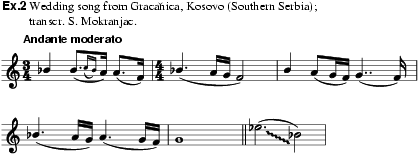

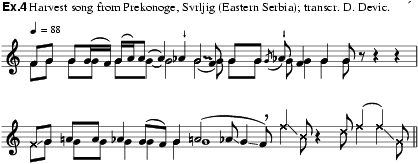

The main difference between traditional songs (which played an important and significant role in the rural community) and the ‘new’, predominantly love songs, is in the emphasis given to the individual. In keeping with this is the genre of two-part ‘bass’ singing. It is thought that this form of singing originated in the Serbian areas of Vojvodina towards the end of the 19th century, and by the beginning of the 20th century it was being heard in other Serbian regions. Although today songs are sung in the new two-part form in many villages, the form does not exist at all in Kosovo and Metohija.
Instead of the above-mentioned predominant 2nd or drone, the ‘new’ singing style emphasizes the bass part, introducing elements of western European harmony, and adopts the term pevanje na bas or ‘singing in bass’ (ex.3 and ex.6). The new stylistic feature of this form lies in the fact that the melodic and bass parts start in parallel 3rds and finish on a 5th. Because the accompanying voice is less mobile, this gives rise to transient harmonies in 2nds and 4ths. Further harmonies are formed when a middle voice is separated from the accompaniment (ex.6). The concept of ‘voice’ has been retained, defining a fixed melody (designated by the term ‘aria’), with the rule that it can only be used with verses that possess the same metric structure. Singing ‘in bass’ allows the song to be started by a single singer, with the others or the accompaniment joining in after two or three bars, or one verse. The bass part, which is sung by five, six or more people, frequently overpowers the melody of the soloist, to the extent that only the bass part is heard (ex.7). Women and men separately sing ‘in bass’ in the same way. Antiphony between groups of men and women is also common, usually at gatherings called sedeljke.
A characteristic of urban songs (gradske pesme) is that they may be sung to instrumental accompaniment. Certain songs are the work of well-known singers and composers. They are characterized by their wide melodic scope (of an octave or more) and a melody consisting of similar rhythmic-melodic models and disassembled trozvuka with clearly noticeable harmonic functions (tonic–subdominant–dominant–tonic). The form of the songs is more complex and is based on a melodic stanza of four verses. Some songs sung in cities of the southern regions possess elements (e.g. augmented 2nds and aksak ifranji rhythm) akin to the Turkish makam (ex.8 and ex.9).
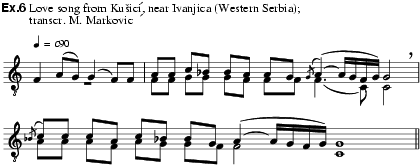
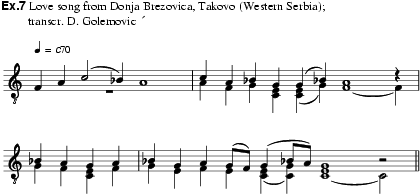
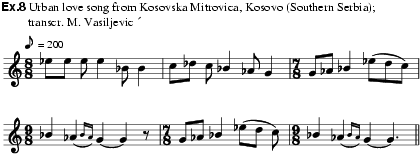

Epic poems accompanied by the gusle are found in Serbia and Montenegro. The singing of epic poems is traditional throughout many parts of Serbia, especially in western regions inhabited by people of Dinaric origin. The singer, also the player, called a guslar, plays in unison with the song. Following a short instrumental introduction the guslar begins to sing, reciting the melodic verses, interspacing them from time to time with short instrumental interludes (ex.10). The songs are tetrachordal and have a single melodic formula which is continuously varied. The main verse is the ‘epic’ or ‘heroic’ asymmetric decasyllable (4 – 6) with parlando rubato rhythm. At one time songs were sung by joining non-rhyming decasyllables. However, modern singers tend to use a rhyming decasyllabic or octosyllabic distich. Equally, the old vocal technique and intonation used to have an irregularly tempered chromaticism, whereas more modern epic poetry has a more diatonic recitation. Medieval subjects and subject matter are greatly cherished by older guslars. The most common themes are those about the struggle for liberation from the Turks and those regarding events from the recent national past. Alongside epic poems, in certain parts of Serbia (around Kosovska Mitrovica and Ivanjica), women perform wedding songs while turning a copper pan.

Rural and urban songs are based primarily on different types of verseline and rarely on text. The basic verse of Serbian traditional song has ten syllables. Its metric structure (4–6) is most often asymmetric (ex.1, ex.2, ex.4, ex.5, ex.6 and ex.7). However, songs of eight syllables also occur, usually as a symmetric octosyllable (4 – 4). Verses and stanzas are formed through the repetition of verses or their parts. Units are frequently formed by combining identical or contrasting musical sections, i.e. either AA or AB. ABA form is not at all common and any greater complexity depends on the way the text is repeated (ex.1, ex.4 and ex.7). Most religious and traditional songs are structured from a single verse with no rhyme (ex.2 and ex.3). A refrain is also common. The rhyming distich is a recent occurrence, adopted under the influence of artistic poetry. Songs of urban origin usually have a complex form (AABBBB), based on a rhyming quatrain.
Rhythmically, Serbian traditional song falls into two broad categories, either parlando rubato or giusto syllabic rhythm. The first is characteristic of songs in which words are freely linked to the melody (ex.1, ex.2, ex.3, ex.4 and ex.5), while the other is characteristic of songs accompanied by dance. A particular asymmetric rhythm (aksak ifranji) is sometimes initiated by the tempo or is a remainder of Turkish influence (ex.8).
In
vocal music the melodic structure of Serbian song is formed by a group of
several tones, of which the tonic is usually the second degree. It is
theoretically possible to define two basic tetrachords: f–g–a![]() –a (ex.1, ex.4 and ex.5); and f–g–a–b (ex.2, ex.3 and ex.7). The first is characteristic of the
older type of songs with intervals that have irregular temperament. Otherwise,
the majority of Serbian songs usually has a small ambitus, and they are sung in
accordance with the diatonic scale.
–a (ex.1, ex.4 and ex.5); and f–g–a–b (ex.2, ex.3 and ex.7). The first is characteristic of the
older type of songs with intervals that have irregular temperament. Otherwise,
the majority of Serbian songs usually has a small ambitus, and they are sung in
accordance with the diatonic scale.
Traditional
melodies in Serbia also possess other tonal formations, ‘scales’, which can be
found in urban songs and are considered to be of foreign origin: e.g. g–a![]() –b–c–d–e
–b–c–d–e![]() (ex.8), g–a–b
(ex.8), g–a–b![]() –c–d–e–f
–c–d–e–f![]() , g–a
, g–a![]() –b
–b![]() –c–d–e
–c–d–e![]() –f (ex.9). The majority of melodies have gradually
descending intervals (na korak or ‘in steps’), but urban songs
have greater intervallic jumps, which favours their western European
harmonization (ex.9). In urban areas with Muslim populations
(Sandžak, Kosovo and Metohija), an augmented second is used in the melody as
the nucleus of the ‘oriental tetrachord’ (ex.9).
–f (ex.9). The majority of melodies have gradually
descending intervals (na korak or ‘in steps’), but urban songs
have greater intervallic jumps, which favours their western European
harmonization (ex.9). In urban areas with Muslim populations
(Sandžak, Kosovo and Metohija), an augmented second is used in the melody as
the nucleus of the ‘oriental tetrachord’ (ex.9).
Yugoslavia, §III, 1: Traditional music: Serbia
Today the most numerous group of instruments in Serbia is that of aerophones. The frula is a short, cylindrical shepherd's flute (25–30 cm), with six holes and, as the most popular instrument in Serbia, it can be found in (almost) every region and even in cities. Another flute, the duduk, has a longer pipe (40–50 cm), six holes and is more usually found in mountainous areas. The cevara is similar to the duduk (c80 cm) and is well known as a shepherd's instrument. It has seven holes on the front and an eighth hole on the back. The cevara also has four additional holes (glasnici) in the lower end to amplify sound. All these single-pipe flutes are made by village craftsmen from different woods (e.g. plum, ash, dogwood). The dvojnica is a double flute made from a single piece of wood and can be short or long (30–45 cm). The holes are arranged with three on the left and four on the right pipe. They are played in a style similar to traditional two-part singing. The kolo, a traditional dance, is usually performed to the music of a frula or similar instrument (ex.11), while songs and improvisations are played on the dvojnica (ex.12). The dvojnice, which used to be found in eastern regions of Serbia and further afield in the mountainous areas of the Balkans and Carpathians, had six holes in one pipe, while the other pipe served as a drone.
Single reed aerophones are less common. Those instruments that are handcrafted (e.g. the karabica, a kind of frula made from cane or elder wood) are used mostly by children in Serbian villages, who often make them themselves. They also make somewhat different kinds (paljka, surla, karabe), fashioned from elder wood or long pumpkins, with several holes on the front. These instruments are used to entertain the villagers during autumn celebrations (sedeljke), where the young people sing and dance.
The gajde is a bagpipe used to play polyphonic songs and dances (see illustration.). Two-part gajde have a single chanter, eight holes and a longer drone. Different types are found in different regions: the small gajde in eastern areas; the middle-sized gajde in southern areas (ex.13); and the smallest gajde found in the south-west. A distinguishing feature of the two-part gajda is that the chanter has five holes and is the same length as the drone. On three-part gajde the chanter consists of two pipes. There are five holes on the first pipe and a single hole on the second, which permits two-part playing; another large, long pipe produces a deep drone (ex.14). There are two types of three-part gajde: a middle-range gajda from eastern and western Serbia and a large gajda from Vojvodina. Large gajde use manual bellows to fill the wind-bag, instead of a mouth-pipe. The gajda player is called gajdaš or gajdar; in the Banat area they are called svirac (‘player’). The player may also sing to the accompaniment of the gajde, which is often done at weddings. Today gajde serve as accompaniment to dances, though they were once used during wedding ceremonies in those areas where they are commonly found.
Shawms (oboes) have a double reed and conical bore. Some are made from bark spirally wound in the shape of an elongated cone and are used in Serbian villages as seasonal instruments. During spring nights shepherds play these instruments by the sheepfold, in the belief that their music will protect their flock from disease. More complex shawms, called zurle (similar to the Turkish zurna), are used by ethnic Albanians in Kosovo and Metohija.
The bark trumpet is also seasonal and is made by shepherds from the bark of the lime tree, forming two hollowed-out hemispheres 2·5–3·5 m long. A copper and wooden mouth-piece (mundstuck) is then plugged into the narrow end. Every year, on St George's Day (Djurdjevdan), the shepherds fashion their wooden trumpets, which they call rikalo or bušen. They then play signals and melodies in the belief that this will influence the fertility of their sheep and cattle and protect their herd from disease (ex.15).
The gusle is a single-stringed chordophone that is used to accompany epic or heroic poetry. It is thought they were used by singers of epics at the feudal courts of medieval Serbian kings. Nowadays each player, called a guslar, crafts his own instrument, usually from maple wood. By comparing the resonating chambers, called varjače (lit. ‘ladles’), of different gusle, a number of types can be identified: the Serbian gusle, with a chamber shaped like an elongated rhombus; the Montenegrin gusle; and the Hercegovinian gusle with a similar pear-shaped resonant chamber. The gusle has a skin with a number of apertures stretched across the resonant chamber. A single string runs across a wooden bridge and along the entire length of the body, which merges into the back. The string of the gusle is made from approximately 40 thin strands of horsehair. The headstock of the gusle is characteristically fashioned in the likeness of a horned animal and has a wooden peg located in the lower part. The bow is short and arched. Before beginning to play, the guslar tunes his instrument to his voice; he sings sitting on a chair with his legs crossed, holding the gusle at an angle across his knee. In the 19th century every household in Serbia possessed its own gusle and singer.
The ćemane is another chordophone similar to related instruments (e.g. the lira) in Bulgaria, Macedonia and Greece. The ćemane can be found in south-eastern parts of Serbia. The earliest representation of this instrument is portrayed on a fresco from the 14th century in the monastery of Dečani. Modern players fashion ćemane from a single piece of wood. They have a pear-shaped body and a short neck with a number of pegs. The resonating chamber is covered with a thin board made from the wood of a fir tree and has two semicircular holes in the middle. The bridge can accommodate three or four metal strings and is supported from below by a small column. The bow is similar to that of a doublebass. The first string is stopped with the finger-nail. Ćemane are used to accompany lyric songs, though more often as accompaniment to folk dances.
The violin and tambura are also used in Serbian traditional music. The earliest historical records show that Gypsies used the violin in the 18th century in certain places in north-western Serbia, while the tambura as it is today was used in Vojvodina no earlier than the 19th century. These instruments are now used mainly by urban ensembles and orchestras.
A number of membranophones (the snare drum, daff, tambourine and darabukkah) are commonly found in Kosovo and Metohija. Included among the membranophones is the ćupa. This is a type of friction drum made from a clay cup covered on one side with a membrane. In the centre of the membrane there is a narrow opening through which passes a narrow reed or leather strap that the player rubs to generate sound. The role of this instrument was to make noise during carnivals. Idiophones of a variety of shapes and names are made and used by village children (e.g. the ergtalka, a button on a string).
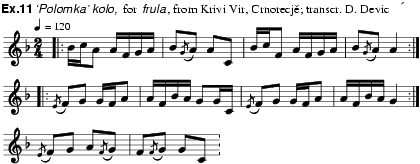
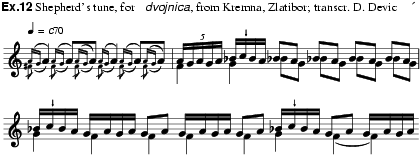
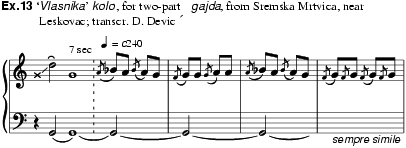
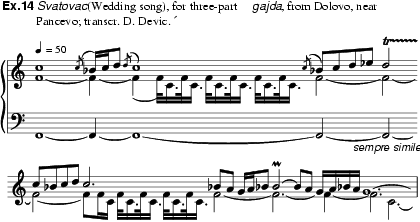

Yugoslavia, §III, 1: Traditional music: Serbia
Many musical instruments, especially the various types of flutes, are not absolutely tuned and their tone ranges often have an irregular temperament. However, because of a tendency to use such instruments, especially the smaller flutes (frule), in folk orchestras, they are now tuned alike during the manufacturing process. Many instruments such as the trumpet, clarinet, flute, saxophone, guitar and violin are used in a variety of combinations in so-called ‘folk orchestras’.
Instrumental ensembles appeared at the beginning of the 20th century. Their evolution and composition depended on the number of players, the availability of different instruments and on inherited traditions. Up until the 1960s and 70s, many small village orchestras (Šumadija, Pomoravlje) existed, which were composed exclusively of stringed instruments (two or three violins, viola and doublebass). In some parts of Vojvodina, there are four-part tambura orchestras (of prim, bas-prim, terc-prim and veliki bas), with up to ten members. Popular village brass bands existed in a number of Serbian regions, formed from a variety of trumpets (often Flügelhorns) and the later addition of a drum with bells and a small drum called doboš. Such village orchestras in eastern, western and southern Serbia have been encouraged by the competitive Dragačev Trumpeters’ Fair in Guča (Dragačevski sabor trubača u Guči). From the 1950s to the present day, numerous orchestras of a heterogeneous composition have sprung up in many urban centres, including not only amateurs but also professional musicians.
Yugoslavia, §III, 1: Traditional music: Serbia
Ethnochoreographers have recorded a large number of folk dances in Serbia. These include regionally differing kolos with different choreography, with odd or even beats. Their names usually relate to the manner of dance, origin or region where they are to be found (e.g. banatsko kolo, moravac, banjski čačak, sverkvino kolo, pop-Marinkovo kolo, leskovačka četvorka).
Ritual dances used always to be accompanied by song. Gradually, however, songs are being replaced by instrumental accompaniment. The main function of instruments in Serbia today is to accompany traditional dances. As is the case with songs, instrumental accompaniment can be provided by a single player or by a group. Until recently, the musical accompaniment of dances was provided by flutes (frula, duduk, cevara and dvojnica) or by the gajda, when they were available.
Yugoslavia, §III: Traditional music
The Montenegrin vocal tradition is based principally on single-part and polyphonic singing. Single-part forms are widespread and include laments for the deceased, called tužilice or tužbarice. These are usually the responsibility of women, although men also take part on certain occasions. The verse melody is called a tužbalica, through which the living address the deceased. There are many forms of laments, from the melodically simple octosyllabic verse (4 – 4), to the ornamented 12 syllable verse (4 – 4 – 4). Basing her performance on a traditional melodic model, the tužilica creates a ‘story’ about the deceased. The deceased is mourned from the time of death until burial; also after 40 days, six months, a year and during subsequent years on the day of the person's death. Women can sing laments individually, one after the other, or as a pair taking turns. A solely male form of expressing grief is known among Montenegrins as lelek, a kind of condensed story recited in prose about the deceased person and their life. The remaining genres of single-part songs are lullabies, songs for kolos, wedding songs and love songs.
Two forms of polyphonic, mainly diaphonic, singing exist in Montenegro, which might be termed old and new. While the old form predominates across a greater area, the newer form is encountered usually in the Bay of Kotor and along the Montenegrin coast. The old style (‘out of the voice’ or iza glasa, ‘vocal’ or glasački and ‘shouting’ or izvika) is characterized by melodic elements of small ambitus with irregular temperament, and sometimes with ornamentation, which is more suited to the female voice and therefore occurs more frequently in songs performed by women (ex.16). A particular tremolo ornamentation occurs in male singing (ex.17). Most older songs use heterophony. In these the soloist and the accompaniment seem to begin both the melody and its ornamented version simultaneously, resulting in characteristic 2nds (ex.18). A large number of Montenegrin songs are similar in terms of melody and singing style to those in western Serbia. This is not surprising, since Montenegro and upper Hercegovina have supplied Serbia with new populations for centuries. Apart from melodic similarities and a method of heterophonic singing, these songs also share similar lyrics.
New forms of singing are found in urban areas, especially in the larger towns. These single-part songs usually have a wide ambitus (particularly love songs, Podgorica and Kotor, which differ from rural songs in their rhythm) as well as having western European harmonic characteristics. The new two-part singing style with its homophonous structure is related to songs that are sung ‘in bass’ in Serbia. Where the soloist and accompaniment are clearly separated, the singing is in parallel 3rds with a cadential 5th (ex.19). Three-part singing is very similar to the polyphonic singing found in coastal and island towns in Dalmatia.
Song forms in Montenegro mainly have a two-part structure (ex.18). The complex songs characteristic of urban environments have greater repetition of verse lines. The structure of Montenegrin traditional song is very similar to Serbian song.
The rhythm of a song depends on the metric complexity of the verses, which generally use (as do Serbian songs) the symmetric octosyllable (4 – 4; ex.16) or the asymmetric decasyllable (4 – 6; ex.17 and ex.18). If the melopoetic structure is restricted by a dance (oro, songs for kolo) then the giusto syllabic rhythm predominates. In songs of different genres, for example in laments, the performance is mainly parlando rubato. Traditional Montenegrin singing, especially two-part singing, has irregular temperament and is based on small tonal groupings. Intonation in a song can be stable, but more commonly individual tones are varied by up to 1/4 of a degree. Sometimes the entire ambitus of a two-part song with four tones falls into a major 3rd. The division of singers according to gender continues to be respected. If young men and women take part together, which is most frequently the case in songs for the kolo, then singing is antiphonal. Such songs are sung as accompaniment to dancing during communal outdoor celebrations (sjednik) at which village youths gather during the winter months.
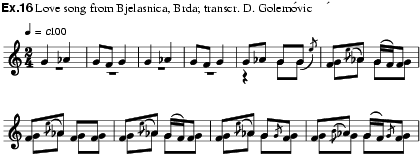
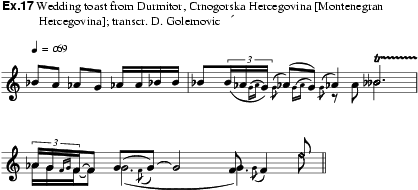
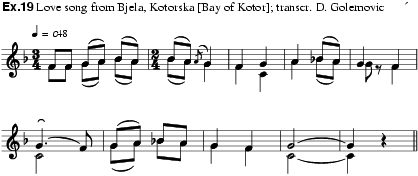
In the mountainous parts of Montenegro, where the people's main livelihood is cattle-raising, the most common instruments are flutes that closely resemble the Serbian frula or dvojnice. The six-hole frula is widespread, ranging from 15–20 cm to 60 cm in length. In the northern mountainous regions of Montenegro, towards the border with Serbia, double flutes, dvojnice, are also in use, and although they are very similar to Serbian dvojnice they are considerably larger. When an improvised shepherd's tune is played on them, it is reminiscent of the old form of Montenegrin and Serbian singing, with a two-part heterophony and drone structure (ex.20).
In the mountainous region of old Montenegro, the diple, a kind of double flute, is most commonly used. The diple is a shepherd's instrument with a single reed and consists of a wind-bag attached to a double chanter and a set of bellows. A chanter similar to the double flute is made from a single piece of wood and has six holes in each pipe, set parallel to each other. There also exists a type of diple without the wind-bag, called zumara, made from canes fastened together with a short piece of horn at the lower end. The players, called diplari, play in the mountains while looking after their flocks, sometimes for two or three hours without interruption. The diple also served as a means of communication between shepherds in the mountains, who would send each other messages (dojave).
Traditionally, the use of aerophones in Montenegro has been limited to the shepherds, as in Albania. The Albanians have adopted another shepherd's instrument, the kaval. This is a long flute without a mouthpiece, identical to the instrument of the same name used by Albanians in Kosovo and Metohija. Montenegrin children make simple single-reed instruments from pieces of straw or cane (in the vicinity of Lake Skadar). In the spring, the children make a kind of shepherd's pipe, called svičak, from thin twigs of willow or ash.
The only chordophone in Montenegro is the gusle (see §1(ii)(6) above). Nowadays they are found in every household, both in the countryside and in towns. Even today the singing of epic poems is an everyday occurrence; guslars are greatly respected and frequently invited to celebrations, where they are treated as honorary guests. A gusle is ‘struck’ or ‘bowed’; it is also said that one sings to a gusle, but plays a flute, duduk or diple.

Montenegrins have always danced the oro without musical accompaniment. The basic types of Old Montenegrin kolos are known as: crnogorsko (the Montenegrin), zetsko (from the old name for Montenegro, Zeta) and crmničko kolo. They are most frequently performed with alternate parts sung in dialogue. There are also different kinds of dances, called skoke (without musical accompaniment), mlado momče (with singing) or dances from Piva, as well as ‘songs for kolos'. The kolo Bokeljske mornarice, (lit. ‘the Fleet of the Bay of Kotor’) is performed every year in Kotor on the day of St Tripun, on 14 February, and is accompanied by the city orchestra.
Yugoslavia, §III: Traditional music
Albanians comprise approximately 6% of the population of Montenegro and roughly 90% of that of Kosovo (Albanian: Kosova), an autonomous province within Serbia. Over 90% of Yugoslav Albanians are Muslim, while the rest are Roman Catholic; virtually all are north Albanians.
In Montenegro and western Kosovo, rural communities have maintained musical practices much like those in the northernmost regions of Albania. Young girls have been among the most active vocalists in these mountain districts, singing specific songs for each stage of the wedding ceremony, as well as for seasonal holidays such as Shingjergj (St George’s Day). Frequently they accompany their singing on frame drum (def or daire). One musical genre unique to this region is the kângë çobaneshave (‘song of the sheperdesses’), sung by girls in the Podgur and Rugovë districts of Kosovo. These songs are executed in a style known as me gisht në fyt (‘with finger on throat’), where each girl uses her thumb to vibrate her larynx while singing. A second local style is the narrow-range, two-part polyphony of girls’ songs from the Opojë district of Kosovo.
Throughout Kosovo links to Ottoman musical practices are evident in newer styles of rural music, and a few songs are sung to well-known Turkish tunes. The most popular men’s instruments in lowland areas have been long-necked lutes such as the two-string çifteli and the larger sharki, which generally has five to seven strings tuned in three courses. Families hosting weddings have often hired semi-professional ensembles of men who sing and play these two instruments, perhaps supplemented by violin, fyell (short end-blown flute) and accordion. These ensembles have customarily alternated long, formulaic historical songs with dance tunes and shorter love songs
For weddings and major religious holidays, families of Roma (Gypsy) musicians have also been contracted to perform. Roma women have sometimes been asked to sing, and perhaps also dance, for women’s wedding gatherings. More frequently, Roma men have been hired to play zurle (double-reed pipe) and lodër (or tupan, two-headed bass drum). In addition to dance melodies, zurle-lodër ensembles have performed medleys of listening music called nibet (from Arabic nawbah) for male wedding guests, as well as lively melodies for Turkish wrestling and other men’s athletic contests.
As in Albania, urban musicians in past decades incorporated features of Ottoman and western European music into their repertories. Songs from Kosovo as well as northern and central Albania have been performed frequently, accompanied by a small acoustic ensemble (çallgi) or its amplified counterpart. In the early 20th century, musicians in Gjakovë (Serbian: Đakovica) developed a distinctive repertory of songs, accompanied by an ensemble of violin, accordion, bugari (four-string lute), mandoll (mandola), 12-string sharki and def. In recent decades the most celebrated singers in this style have been Qamili i Vogël and Mazallom Mejzini.
In the decades following World War II, Albanians in newly socialist Yugoslavia gained considerable cultural autonomy. Priština, (Albanian: Prishtinë), the capital of Kosovo, became home to both an institute of Albanian studies (Instituti Albanoligjik) and the professional ensemble Shota, which showcased folk music and dance of all ethnic groups in the province. Amateur folklore ensembles participated in festivals throughout Yugoslavia, including the Gllogovc festival of village folklore held each year outside Priština. Many hours of folk music (muzika popullore) were broadcast by radio and television stations, while cassettes recorded in Priština were widely distributed in Albanian areas. Recordings of songs in rural style, accompanied by a large ensemble of more than one çifteli, sharki and def, plus other instruments, came to define a distinctive Kosovo sound that was also popular in Macedonia and Albania. As a strong sense of national identity increased among Yugoslav Albanians, singers popularized a number of highly evocative patriotic songs that served as rallying points for the expression of communal sentiments. By the mid-1980s, young Kosovo musicians were also recording albums of Western-influenced rock music.
Beginning in 1989, Kosovo’s autonomous status was rescinded, leading to the closing or dissolution of schools, institutes and other cultural organizations. Recordings of folk and popular music in Albanian were no longer produced or broadcast by the state media, leading to the development of a private recording industry funded largely by the Kosovar Albanian diaspora. As a result of these events, a number of Kosovo musicians have emigrated to western Europe or North America, where they now perform for large expatriate communities. Any re-emergence of a fully public Albanian musical life in Kosovo awaits a resolution of the political situation there.
Yugoslavia, §III: Traditional music
and other resources
F. Kyhač: Južnoslovenske narodne popijevke, 5 vols [South-Slavic folk songs] (Zagreb, 1878–1941)
W. Wünsch: Die Geigentechnik der südslawischen Gusleren (Brno, 1934)
D.S. and L.S. Janković: Narodne igre [Folk dances] (Belgrade, 1934–64) [Eng. and Fr. summaries of i–vi]
P. Brömse: Flöten, Schalmeien und Sackpfeifen Südslawiens (Brno, 1937/R)
B. Bartók and A.B. Lord: Serbo-Croatian Folk Songs (New York, 1951)
M. Murko: Tragom srpsko-hrvatske narodne epike [On the trail of Serbo-Croatian folk epics] (Zagreb, 1951)
Z. Stanković: Narodne pesme u Krajini [Folk songs from the Krajina] (Belgrade, 1951)
M. Vasiljević: Narodne melodije iz Sandžaka [Folk melodies from the Sandžak] (Belgrade, 1953)
S.S. Mokranjac: Zapisi narodnih melodija [Notes on folk melodies] (Belgrade, 1966)
M. Vasiljević: Jugoslavske narodnie pesni iz Sandžaka, zapisan ot narodnogo pevca Hamdii Shahinpashicha [Yugoslav folk songs from the Sandzak, recorded by the folk singer Hamdii Sahinpasica] (Moscow, 1967)
T. Vujićić, ed.: Muzičke tradicije južnih Slovena u Madjarskoj [Traditional music of the South Slavs in Hungary] (Budapest, 1978)
A. Gojković: Narodni muzički instrumenti [Folk instruments] (Belgrade, 1989)
A. Gojković: Muzički instrumenti: mitovi i legende, symbolika i funkcija [Musical instruments: myths and legends, symbolism and function] (Belgrade, 1994)
S.S. Mokranjac: ‘Etnomuzikološki zapisi’ [Notes on ethnomusicology], Sabrana Dela, ix (Belgrade, 1996)
T. Bušetić: Srpske narodne pesme i igre sa melodijama iz Levča [Serbian folk songs and dances with melodies from Levač] (Belgrade, 1902)
L. Kuba: Slovanstvo ve svyech zrevech, v: srpske iz Kraljevine [The Slavonic world in its songs, v: the Serbs of Kraljevina] (Prague, 1923)
V. Djordjević: Narodne melodije, južna Srbija [Folk melodies from southern Serbia] (Belgrade, 1928)
V. Djordjević: Narodne melodije, predratna Srbija [Folk melodies from pre-war Serbia] (Belgrade, 1931)
M. Vasiljević: Jugoslovenski muzicki folklor, i: Kosovo i Metohia [Yugoslav traditional music, i: Kosovo and Metohia] (Belgrade, 1950)
K. Manojlović: Narodne melodije iz istočne Srbije [Folk melodies from eastern Serbia] (Belgrade, 1953)
T. Onufrii: Naša pisnja: Zbornik narodnih i popularnih pisnjoh jugoslavjanskih Rusinox [Our songs: a collection of folk and popular songs from the South-Slavic Ruthenians] (Ruski Kerestur, 1953–4) [booklet]
T. Onufrii: Nasa pisnja: Zbornik narodnih i popularnih pisnjoh [Our songs: a collection of folk and popular songs] (Ruski Kerestur, 1955)
M. Vasiljević: Narodne melodije Leskovačkog kraja [Folk melodies from the Leskovac area] (Belgrade, 1960)
D. Dević: ‘Volksmusikinstrumente auf mittelalterischen Fresken in Serbien und Mazedonien’, Studia instrumentorum musicae popularis IV: Balatonalmádi 1973, 78–84
L. Miljković: Banja [Banja] (Knjaževac, 1978)
P. Vukosavljević: Gajde u Srbiji [Serbian Gajdas] (Belgrade, 1979)
D. Dević: ‘Typen serbischer Sackpfeifen’, Bürgerliche Musikkultur im 19. Jahrhundert in Salzburg: Salzburg 1980, 59–82
D. Golemović and O. Vasić: Narodne pesme i igre u okolini Bujanovca [Folk songs and dance from the vicinity of Bujanovac] (Belgrade, 1980)
D. Golemović and O. Vasić: Istraživanja, i: Valjevska Kolubara [Research, i: Valjevska Kolubara] (Valjevo, 1984)
O. Vasić, P. Vukaslavljević and J. Bjeladinović: Narodne melodije, igre i nošnje peštersko-sjeničke visoravni [Folk melodies, dances and costumes of the Pešter-Sjenica Plateau] (Belgrade, 1984)
P. Vukosavljević: Narodne melodije peštersko-sjeničke visoravni [Folk melodies of the Pešter-Sjeniča Plateau] (Belgrade, 1984)
L. Miljković: Mačva [Mačva] (Sabac, 1985)
D. Dević: Narodna muzika Dragačeva: oblici u razvoj [The folk music of Dragaćev: developing forms] (Belgrade, 1986)
L. Miljović: Donja Jasenica [Donja Jasenica] (Smederevska Palanka, 1986)
N. Fracile: Vokalni muzički folklor Srba i Rumuna u Vojvodini [Traditional vocal music of the Serbs and Romanians in Vojvodina] (Novi Sad, 1987)
D. Golemović: Narodna muzika Podrinja [The folk music of Podrinje] (Sarajevo, 1987)
D. Golemović and O. Vasić: Muzička tradicija i narodne igre Azbukovice [The musical tradition and folk dances from Azbukovica] (Ljubovija, 1989)
M. Kmeć: ‘Slovačke narodne pesme iz Stare Pazove’ [Slovak folk songs from Stara Pazova], Folklor u Vojvodini, iii (1989), 103–12
R. Petrović: Srpska narodna muzika [The folk music of Serbia] (Belgrade, 1989)
D. Dević: Narodna muzika Crnorečja u svetlosti etnogenetskih procesa [The folk music of Crnorečje in the light of ethnogenetic processes] (Belgrade, 1990)
A. Gojković: Proučavanje narodnih muzičkih instrumenata u Srbiji [The study of musical instruments in Serbia] (Belgrade, 1990)
D. Golemović: ‘Muzička tradicija Valjevske Kolubare’ [The musical tradition of Valjevska Kolubara], Istrazivanja odgoja i obrazovanja, vi (1990), 389–430
D. Golemović: Narodna muzika užičkog kraja [Regional folk music from Užiče] (Belgrade, 1990)
O. Vasić: Narodne igre i zabave u titovoužičkom kraju [Folk dances and celebrations from the area of Titovoužiče] (Belgrade, 1990)
S. Vukosavljev: Vojvodjanska tambura [The tanbur in Vojvodina] (Novi Sad, 1990)
E. Kiralj: Zbirka romskih (ciganskih) narodnih pesama iz Vojvodine [Collection of Romany (gypsy) folk songs from Vojvodina] (Budapest, 1992)
O. Vasić: Igračka tradicija Podrinja [Dance tradition of Podrinje] (Sarajevo, 1992)
J. Dokmanović: ‘Žensko obredno pevanje u srpskom Šopluku’ [Women’s religious singing in the Serbian Šopluko], Novi zvuk, no.1 (1993), 85–94
D. Golemović and O. Vasić: Takovo u igri i pesmi [Takovo in dance and song] (Gornji Milanovac, 1994)
M. Marković: ‘Etnomuzikologija u Srbija’ [Ethnomusicology in Serbia], Novi zvuk, no.3 (1994), 19–30
M. Ilijin: Narodne igre u Boku Kotorskoj [Folk dances from the Bay of Kotor] (Belgrade, 1953)
M. Vasiljević: Narodne melodije Crne Gore [Folk melodies from Montenegro] (Belgrade, 1965)
V. Šoć: Starocrnogorske narodne igre [Folk dances from old Montenegro] (Zagreb, 1984)
M. Vukičević-Zakić: Diple Stare Crne Gore [The diple in old Montenegro] (Belgrade, 1984)
L. Kuba: U Crnoj Gori [In Montenegro] (Podgorica, 1996)
Y. Arbatsky: ‘Proben aus der albanischen Volksmusikkultur’, Südostdeutsche Forschungen viii (1943), 228–55
Y. Arbatsky: Beating the Tupan in the Central Balkans (Chicago, 1953)
L. Antoni: Folklori muzikuer shqiptar [Albanian musical folklore] (Prishtinë, 1956–77)
Sh. Pllana: ‘Uloga individualnih stvaralaca u razvitku savremenog albanskog narodnog pevanja na Kosovu i Metohiji putem štampe, radija i gramofona’ [The role of the individual creator in the development of contemporary Albanian folk singing in Kosova and Metohija by means of the press, the radio, and the gramophone], Yugoslav Folklore Association: Congress XIII: Dojran 1966, 229–37
A. Linin: ‘Šarkija kod albanaca na Kosovu’ [The sharki among the Albanians of Kosova], Glasnik Muzeja Kosova/Buletini i Muzeut të Kosovës [Annual of the Museum of Kosova, Prishtinë], x (1970), 355–60
A. Schmaus: Gesammelte slavistische und balkanologische Abhandlungen (Munich, 1971)
B. Traerup: ‘Rhythm and Metre in Albanian Historical Folk Songs from Kosovo (Drenica) Compared with the Epic Folk Songs of Other Balkan Countries’, Makedonski Folklor [Macedonian folklore, Skopje], iv/7–8 (1971), 247–59
A. Lorenc: Folklori muzikuer Shqiptar [Albanian traditional music], vi (Priština, 1974)
B. Traerup: ‘Albanian Singers in Kosovo: Notes on the Song Repertoire of a Mohammedan Country Wedding in Jugoslavia’, Studia instrumentorum musicae popularis, iii (1974), 244–51
F. Födermayr and W.A. Deutsch: ‘Zur Akustik des “tepsijanje”’, Neue etnomusikologische Forschungen: Festschrift Felix Hoerburger, ed. P. Baumann, R.M. Brandl and K. Reinhard (Laaber, 1977), 97–112
B. Traerup: ‘Wedding Musicians in Prizrenska Gora, Jugoslavia’, Musik og Forksning [Copenhagen], iii (1977), 76–94
R. Munishi: Këndimi i femrave të Podgurit [Girls' and women's singing in Podgur, Kosova] (Prishtinë, 1979)
J. Reineck: ‘The Place of the Dance Event in Social Organization and Social Change among Albanians in Kosovo, Yugoslavia’, UCLA Journal of Dance Ethnology, x (1986), 27–38
F. Hoerburger: Volksmusikforschung: Aufsätze und Vorträge 1953–1984 über Volkstanz und instrumentale Volksmusik (Laaber, 1986)
R. Munishi: Këngët malësorce shqiptare [Albanian songs from Malësi] (Prishtinë, 1987)
J. Kolsti: The Bi-Lingual Singer: A Study in Albanian and Serbo-Croatian Oral Epic Traditions (New York, 1990)
F. Hoerburger: Valle popullore: Tanz und Tanzmusik der Albaner in Kosovo und in Makedonien, (Frankfurt, 1994)
J. Sugarman: ‘Mediated Albanian Musics and the Imagining of Modernity’, New Countries, Old Sounds? Cultural Identity and Social Change in Southeastern Europe, ed. B.B. Rener (Munich, 1999)
Jugoslavija: muzika i tradicija [Yugoslavia: music and tradition], coll. D. Dević, Radio-Televizija Beograd RTB LPV 190 (1971)
Srbija: muzika i tradicija [Serbia: music and tradition], coll. D. Devic, Radio-Televizija Beograd RTB LPV 192 (1974)
Narodna muzička tradicija: Srbija (instrumenti) [The tradition of folk music: Serbia (instruments)], coll. D. Devic, Radio-Televizija Beograd RTB 2110030 (1978)
Narodna muzička tradicija: Srbija (instrumentalni ansambli) [The tradition of folk music: Serbia (instrumental ensembles)], coll. D. Dević, Radio-Televizija Beograd RTB 2110049 (1978)
Narodna muzička tradicija: Srbija (pesme i igre Kosova) [The tradition of folk music: Serbia (songs and dances of Kosovo)], coll. D. Dević, Radio-Televizija Beograd RTB 2110073 (1981)
Srpska narodna muzika [Serbian folk music], coll. R. Petrović, RTB LP 2510057 (1981)
Sve devojke na sedenjku dosle [All the girls have come to the celebration], coll. R. Petrović, DISKOS LPD 001 (1985)
20 godina smotre narodnog stvaralastva ‘Homoljski motivi’: Kučevo [A 20- year review of national creativity, ‘Motifs of Homolje’: Kučevo], coll. D. Dević, Radio-Televizija Beograd RTB NL 0069 (1987)
‘Sve je sveto i čestito bilo’: guslerske pesme po zapisima Vuka St Karadžiča [‘All was holy and honourable’: songs for the Gusle as recorded by Vuk St Karadžič], coll. D. Devic, Radio-Televizija Beograd RTB LP 201103 (1987)
Pevačice iz Ribaševine [Women singers of Ribasevina], coll. D. Golemović, Radio-Televizija Beograd RTB NL 0046 (1989)
Podjo’niz polje, ne znam niz koje … : muzička tradicija Podrinja [I set off down the field, I know not which ... : the musical tradition of Podrinje], coll. D. Golemovic, Radio-Televizija Beograd RTB NL 0043 (1989)
Dobrodošli na Rudnik: tradicionalna narodna muzika iz sela Crnuća na Rudniku [Welcome to the mine: traditional folk music from the village Crnuć na Rudniku], coll. R. Petrović, Radio-Televizija Beograd RTB LP 004 (1990)
The Balkans and its Musical Roots: Serbian Folk Music, coll. D. Golemović and D. Dević, ITV Melomarket CD 3004 (1995)
Muzička tradicija Crne Gore [The musical tradition of Montenegro], coll. D. Golemović, Pergamena (1996)
Kosova këndon dhe vallëzon [Kosova sings and dances], Radio-Televizija Beograd LPV 1251
Kosovarja këndon [The Kosova woman sings], Radio-Televizija Beograd 2110296
Vaj moj lule [Alas, oh flowers], Jugoton LPY-V-853
Bilbili i Kosovës: Nexhmie Pagarusha [The nightingale of Kosova: Nexhmie Pagarusha], Rozafa 021
Bilbili i Kosovës: Shyhrete Behluli [The nightingale of Kosova: Shyhrete Behluli], Albanota CD-019
Këndojnë Bilbila: Qamili i Vogël e Mazllom Mejzini [The nightingales sing: Qamili i Vogël and Mazllom Mejzini], EuroLiza CD-029